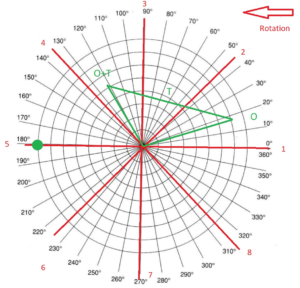In our last “How To” we talked about the trial run – using a trial weight and location, to calculate the amount and location of a correction weight, which should correct the unbalance. Most modern-day balancing tools do the math for you. Even though these tools calculate the correction weight and location, it is good to have some understanding of how to do the calculations yourself.
Remember that a correction weight is a counterbalance to a heavy spot, i.e. you want the correction weight to counter the unbalance forces. And an easy way to explain it is by using a vector or polar graph. Many of us “old timers” performed balancing corrections by using a polar graph.
Here’s how it’s done:
- We take a polar graph, and lay out our rotor. In our example, we’ll use an (8) blade fan. Lay out 8 lines, 45 degrees apart, to denote the blades (shown in red). Number them consecutively and note the direction of rotation.
- In our example, our original vibration is .36 inches per second at 18 degrees (shown in green). O=.36 ips @ 18°
- We draw a line from the center of the graph, in our case, each circle represents 0.05 ips. So we draw a line 7.2 units, or “circles” long, at 18 degrees.

4. We add a trial weight (TW). Ours is 50 grams at 180 degrees.
5. We restart the fan, and measure. Our vibration is now O+T=.26 ips @121 degrees.
6. We draw a line from O to O+T, label it “T”. We measure the length of Line “T” using the same scale as the circles. In our case, T=10.4 units in length.

Here are our numbers:
Original vibration (O)=.36 @ 18° (7.2 units)
Trial Weight (TW)=50 gr. @ 180°
Original + Trial Weight (O+T)= .26 @ 121°
T= (10.4 units long)
To calculate our correction weight size, we use this formula:
Correction Weight = Trial Weight x (Original / Length of Line T) or CW=TW x (O/T)
CW=50 x (7.2 units/10.4 units)
Our Correction Weight is 34.6 grams.
Now to figure the location. On our graph, going from Line “O” to “O+T” is counterclockwise, at an angular change of 106°. We place our Correction Weight 106° in the opposite direction (180°-106°=74)
We remove our trial weight and add our Correction Weight of 34.6 grams @ 74°.
That’s the math. We could also trim balance the fan even closer, by continuing this graphing process again.
But now, we have another problem. There is no blade exactly at 74 degrees. We would have to split the weight, so that two separate weights would counter the unbalance. We have one blade at 45°, and one at 90°. Fortunately, most balancing machines (including our Fixturlaser SMC and OneProd Falcon) can calculate the weight split. There is a graphical method of doing this as well, called the Parallelogram method.
If you’ve made it this far, GREAT! Be glad your balancing equipment calculates for you!




2 Comments
Hi Stan,
I would like to know how you have calculated the angular change of 106°.
Thank you for the useful information of your blog.
Roberto
Thanks Roberto. It appears I made a mistake. The shift from “O” to “O+T” (18 deg. to 121 deg.) is actually 103 degrees, not 106.